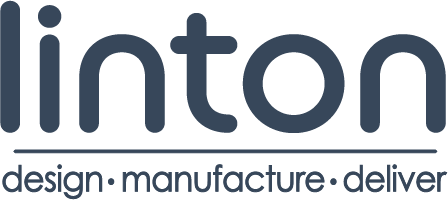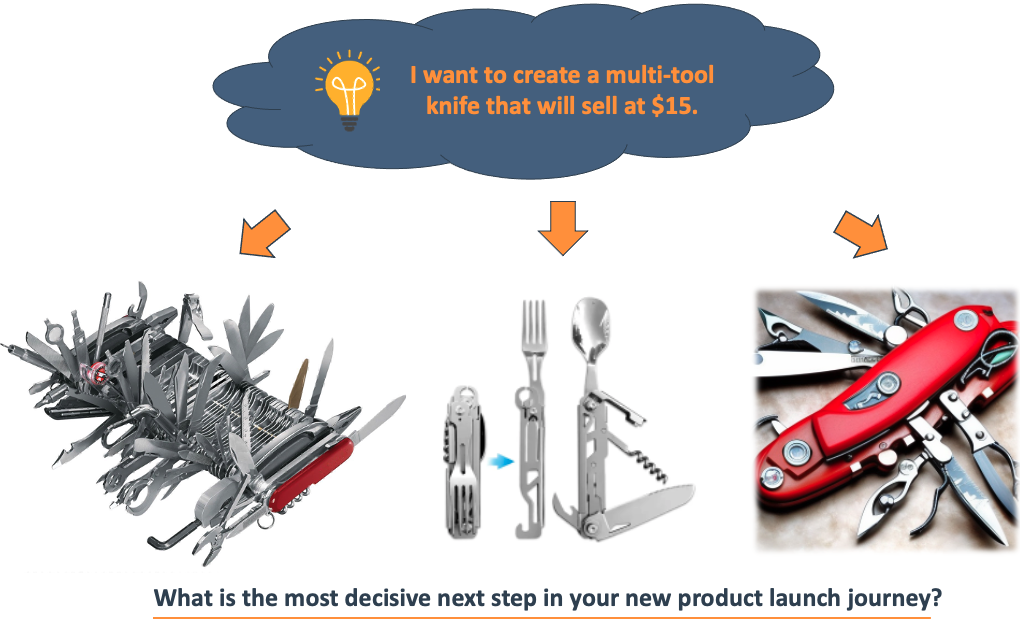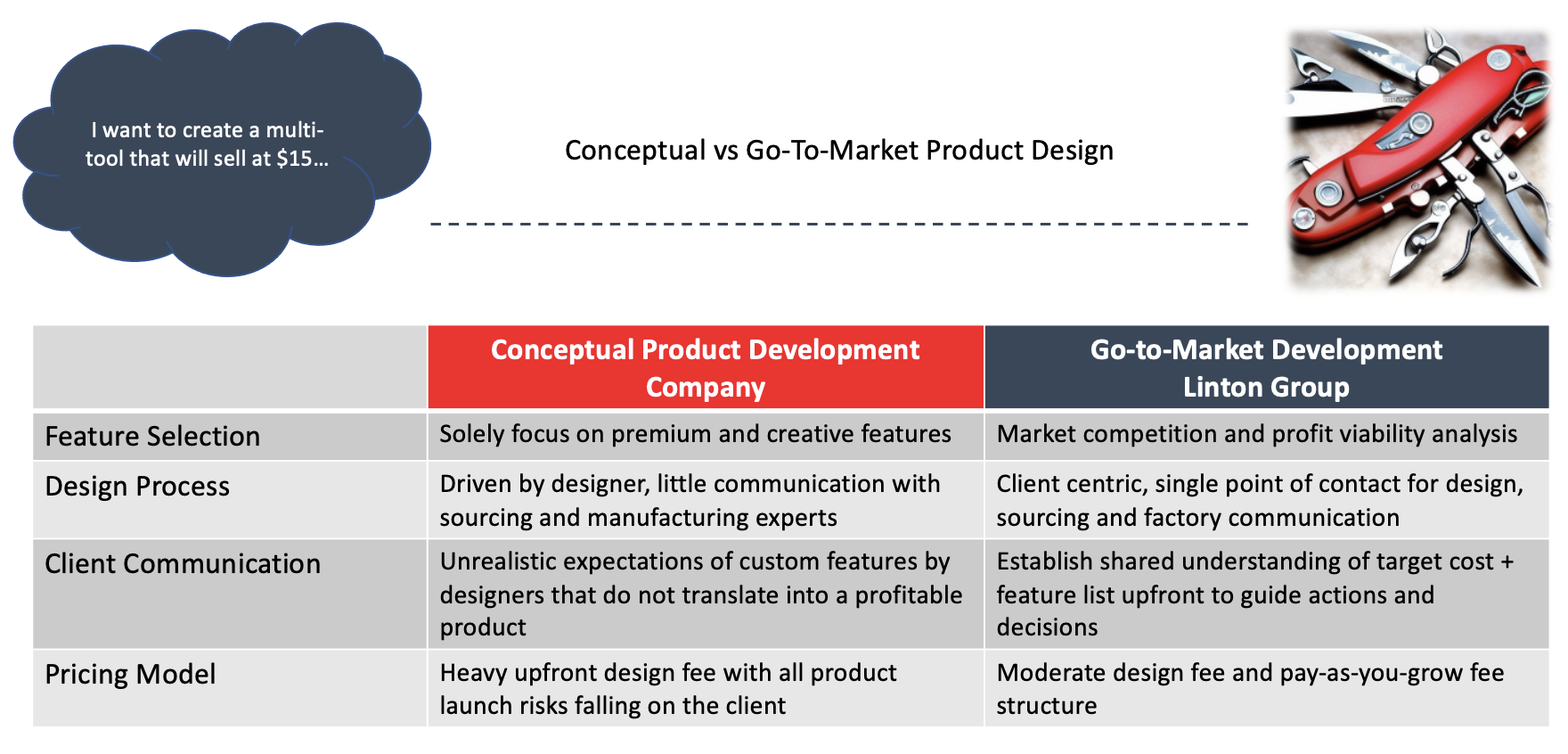Go-to-Market New Product Development
Conceptual and go-to-market product design are two important stages in the product development process. Each stage requires specific skills and expertise to ensure a successful outcome. In this article, we will explore the differences between conceptual design and go-to-market product development. Many product development companies are very heavy on the artistic design elements of new product development, but they lack the resources and abilities to bring the product to market. What good is a beautiful design if the final product does not sell or if it is simply not profitable?
Conceptual Design
Conceptual design is the first stage of product development. This stage involves defining the problem and identifying the solution. This is the stage where product ideas are conceived, and the concept is developed. The conceptual design stage is focused on defining the product’s purpose, target market, and the benefits that the product will provide to customers. Additionally, an artistic design will be a crucial element in presenting your ideas to investors.
During the conceptual design stage, the product design team conducts market research, analyzes customer needs and wants, and identifies any potential gaps in the market. They create product concepts, sketch product designs, and develop renderings to present their ideas. The main goal of the conceptual design stage is to create a viable product concept that addresses the needs of the target market and aligns with the company’s goals.
The conceptual design stage requires creativity, innovation, and problem-solving skills. The product design team must be able to think outside the box and come up with new ideas that address the problem at hand. They must also be able to evaluate the feasibility of each concept and identify any potential roadblocks early in the process.
Go-to-Market Design
Once the product concept has been defined and refined, it’s time to move on to the go-to-market product design stage. This stage involves turning the product concept into a tangible product that can be manufactured and sold, and most importantly, can make profit. It is the stage where the product design team takes the product idea and turns it into a reality.
During the go-to-market product design stage, the product design team works on developing the product’s features, functionality, and aesthetics. They focus on the technical details of the product design, including design for manufacturing, engineering, feature fine-tune, material selection, and manufacturing processes. They also work on creating detailed product specifications and creating 3D CAD models and renderings.
The main goal of the go-to-market product design stage is to create a product that is not only functional but also visually appealing and user-friendly. The product design team must ensure that the product is feasible to be manufactured and economically viable, meets all technical specifications, is easy to use, and is aesthetically pleasing. They must also ensure that the product can be manufactured efficiently and cost-effectively.
Creativity & Practicality
While conceptual design is a crucial aspect of product development, it is not the only factor to consider. Creating a successful product requires more than just good ideas and beautiful presentation. It also requires the ability to turn that idea into a tangible, profitable and market-ready product.
During the conceptual design stage, designers and engineers are focused on coming up with a creative solution that meets the needs of the customer. They will typically use sketches, 3D models, and other tools to visualize the product and its features. There is a heavy artistic element to this stage that requires creativity and out-of-the-box thinking. Art-heavy product development companies generally thrive in this area, but it is crucial to keep the practical elements that define the success of a product at the forefront of this process.
Go-to-market product design, on the other hand, focuses on turning those conceptual designs into a tangible product that can be manufactured, tested, and brought to market to be sold for a profit. This involves developing detailed design specifications, selecting materials and manufacturing processes, conducting feasibility studies, and testing prototypes. The ultimate goal of go-to-market product design is to create a product that meets the needs of the customer, is cost-effective to manufacture, and can be successfully launched in the market. A successful go-to-market design is backed by real numbers and manufacturing experience.
Product Development Red Flags
While both conceptual design and go-to-market product design are essential parts of the product development process, be mindful of hiring a sourcing partner that is heavy in conceptual design but cannot build a tangible go-to-market product. Watch out for these red flags during your product development journey.
-
Cost Overruns -$X,XXX
A company that is focused solely on conceptual design may not have the necessary expertise to identify potential manufacturing or production issues. This can result in cost overruns as the product moves from design to production, causing delays and budget overruns.
-
Delays in Product Launch -$X,XXX
Without the ability to turn conceptual designs into a tangible product, there is a risk of delays in the product launch. This can occur if the company is unable to create a product that meets the necessary quality standards or if there are issues with the manufacturing process.
-
Inability to Scale Production -$X,XXX
Even if the company is successful in creating a tangible product, they may not have the necessary expertise to scale production to meet demand. This can lead to delays in delivery times or the inability to meet customer demand, resulting in lost sales.
-
Lack of Communication -$X,XXX
A company that is heavy in conceptual design may not have a clear understanding of the manufacturing process, resulting in communication breakdowns between the design team and the production team. This can lead to misunderstandings, delays, and costly mistakes.
-
Limited Product Innovation -$X,XXX
Focusing solely on artistic concept design may result in a lack of product innovation. Without the ability to create a tangible product, there is a risk that the company may not be able to identify potential issues or develop new product features.
-
Lack of Manufacturing Knowledge -$X,XXX
Design without manufacturing in mind can lead to an over-designed product that is too expensive to produce and unable to turn a profit.
To avoid designing a product that will fail the market test, it is vital to work with a company that has expertise in both conceptual design and go-to-market product design. This requires a team that can take a product from initial concept through to manufacturing and launch, ensuring that the final product meets the necessary quality standards, is cost-effective to produce, and can be successfully launched in the market.
When evaluating potential product design firms, look for a company that has experience in all aspects of the product development process. This includes design, engineering, manufacturing, and quality control. A company that has a clear understanding of the manufacturing process and can work closely with factories is critical to avoiding delays and cost overruns.




